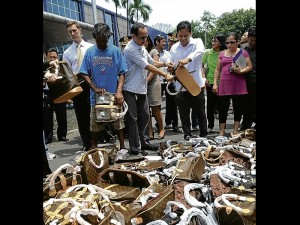
PHILIPPINE authorities slash and tear bogus products to mark World Anti-Counterfeit Day. According to global luxury brand Louis Vuitton, the price of imitation goods sold on the market may be low, but it exacts a higher cost on the children who help produce these illegal products.
Imitation may be the highest form of flattery, but it is not what global luxury brand Louis Vuitton needs or wants.
Still, the European manufacturer gets more than its fair share of bogus products, which explains the proliferation of millions of dollars worth of fraudulent Louis Vuitton goods in the marketplace here and abroad.
Earlier this month, Philippine authorities destroyed $39.4 million, or some P1.6 billion, worth of fake goods to mark World Anti-Counterfeit Day.
Unfortunately for the French company founded in 1854, a good portion of the five months worth of seized items that were destroyed by the Manila Police bore counterfeit Louis Vuitton trademarks, particularly the distinctive monogram created in 1896 by Georges Vuitton, the founder’s son.
But there are still millions of pesos worth of counterfeit Louis Vuitton products out there—mainly bags and wallets. And Louis Vuitton has no intention of letting up on its global campaign to rid the market of every last one of them, no matter how seemingly small and insignificant the products are.
According to Jean-Baptiste Debains, president of Louis Vuitton Asia Pacific, the company maintains a “zero tolerance policy” on counterfeiting as it firmly believes that behind these fraudulent goods are powerful criminal organizations and child labor practices that must be stopped.
This fact, however, is often lost on the buyers of counterfeit goods who are drawn by the opportunity to own and display what looks like the genuine article at a fraction of the price of the original product.
And for many of the patrons of counterfeit goods, there is no big deal about buying fake goods. The important thing is to get what they believe to be the same product at a bargain price.
The price of the product itself may be low, he explains, but it exacts a higher cost on the children who help produce these goods, not to mention the lost government revenue since these producers operate below the radar and thus do not contribute to the government’s coffers.
The proliferation of counterfeit goods—not just Louis Vuitton products—has also kept the Philippines on the US Trade Representative’s lower-level Watch List of countries deemed not doing enough to protect intellectual property rights. This affects the Philippines’ ability to entice foreign companies to invest in the country for fear that their intellectual property rights will be violated.
At the top of the list of pirated or counterfeit items proliferating in the Philippines are software, movies and songs, followed by dry goods. Disturbingly, even medicine, household cleaning products and personal care products, like soaps and shampoos, are now targets of counterfeiters.
And so the drive to stamp out counterfeit goods continues, and Louis Vuitton is not lifting its foot off the accelerator.
Its Intellectual Property Department employs a fully dedicated team that includes lawyers and former law enforcement agents to protect Louis Vuitton’s rights over trademarks and designs.
According to Debains, the company is more determined than ever to protect and preserve the value of the brand in the interest of its clients, along with the artisans and designers whose work makes Louis Vuitton products command a premium.
For those who cannot afford at this time to buy a genuine Louis Vuitton product, Debains recommends that they consider more affordable alternatives.
Just make sure that it’s the real thing.